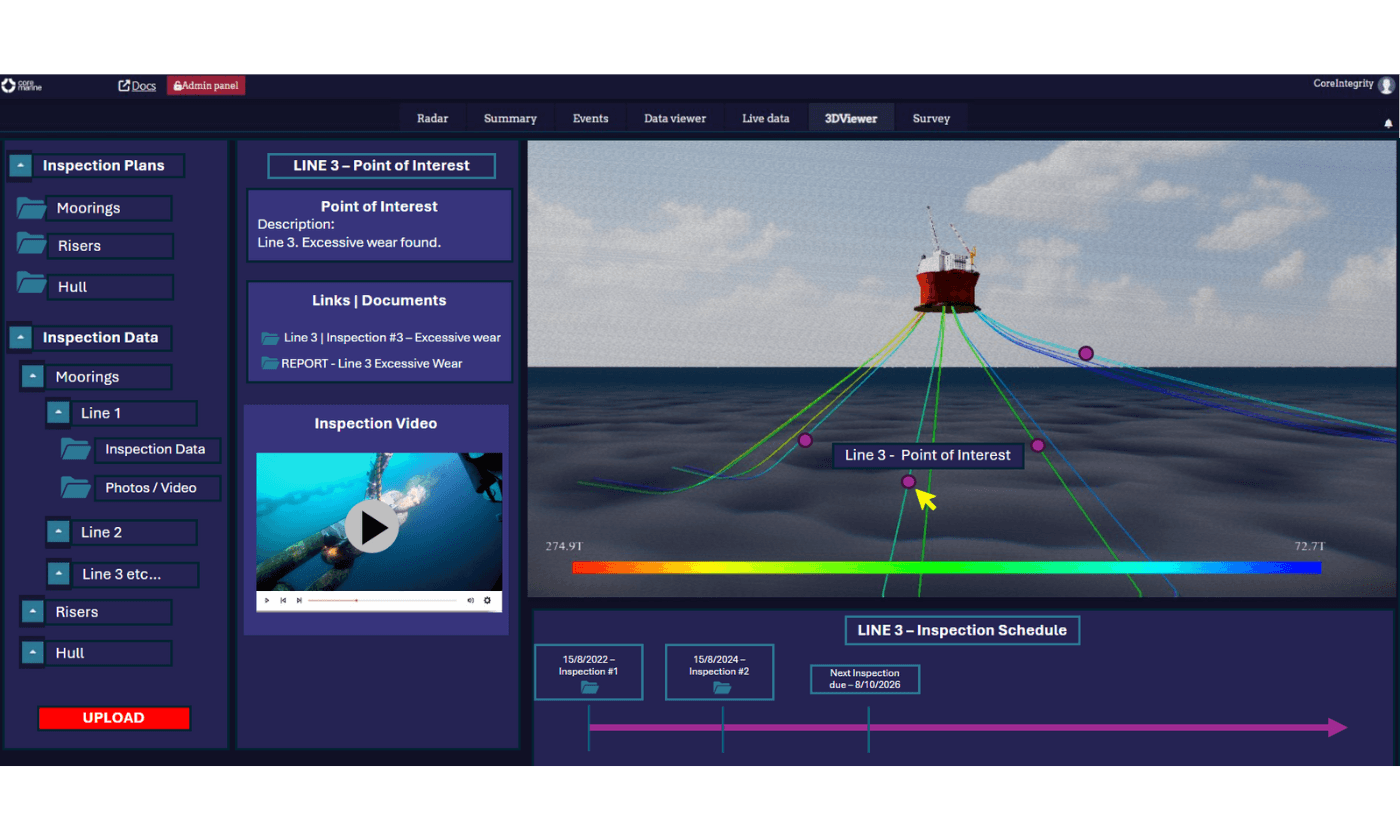September 18, 2024
In the ever-evolving landscape of industrial maintenance, condition based monitoring (CBM) has emerged as a game-changing strategy to reduce maintenance costs and risks.
CoreIntegrity is our cutting-edge CBM solution, developed in-house by a crack team of experienced ocean engineers, data scientists and software developers. We built the tool we wanted to perfect our own offshore design, operations and maintenance – and now it’s transforming how organizations approach asset management, particularly in challenging subsea environments.
What is condition based monitoring?
Condition based monitoring (CBM) is a forward-thinking maintenance strategy which uses real-time data to assess the health and performance of equipment and assets. CoreIntegrity employs advanced sensors to continuously gather data from subsea equipment, moorings, risers, and offshore energy systems. We then run analytics and present the real-time data in a client dashboard, with an alert system flagging any abnormalities. This provides immediate insights to maintenance teams, enabling them to perform maintenance only when indicators suggest potential issues. By implementing CBM with CoreIntegrity, organizations can transition from reactive or scheduled maintenance to a proactive, data-driven approach. This shift not only prevents failures and downtime but also ensures efficient and cost-effective asset management.
The CoreIntegrity advantage
So what’s different about CoreIntegrity? Our system stands out in the CBM market by offering:
- A system designed and built by mariners for mariners. That’s a huge point of difference.
- Comprehensive sensor integration.
- Advanced analytics and risk assessment.
- Customizable solutions for various asset types across offshore industries.
- Seamless integration with existing systems.
Key Components of CoreIntegrity's CBM System
- Data Collection
CoreIntegrity employs a state-of-the-art sensor network to gather live data on asset conditions. Depending on the use case and asset requirements, these sensors can include:
- Accelerometers: To measure vibration and motion.
- Laser sensors: To provide precise distance and alignment data.
- Strain gauges: To monitor structural stress and fatigue.
- Acoustic sensors: To detect anomalies in subsea equipment.
We configure our data collection approach to individual assets, allowing you to build a comprehensive view of subsea systems, moorings, flexibles, and floating structures.
- Data Analysis
CoreIntegrity's powerful analytics engine processes the collected data to:
- Identify patterns and trends,
- Detect and alert to anomalies and potential issues,
- Predict maintenance needs, and
- Assess asset risk levels.
- Decision Support
The CoreIntegrity platform empowers teams with:
- Real-time dashboards and alerts,
- Customizable reports,
- Risk-based inspection planning, and
- Maintenance optimization recommendations .
Benefits of Implementing CoreIntegrity
- Reduced downtime: Predict and prevent failures before they occur.
- Extended asset Lifespan: Optimize maintenance to prolong equipment life.
- Cost savings: Reduce unnecessary maintenance and prevent costly failures.
- Enhanced safety: Minimize risks associated with equipment malfunction.
- Improved resource allocation: Focus efforts on high-risk assets.
- Increased operational efficiency: Streamline maintenance planning and execution.
- Data-driven decision making: Base choices on real-time, accurate information.
Implementation Process
We recommend taking a systems-based approach to developing and implementing a CBM system. CoreIntegrity comes with a configurable set of software modules that are combined with a customised sensor package depending on your use case and asset requirements. We deliver CoreIntegrity in a streamlined, seven-step implementation process:
- Requirements analysis: Understand your unique needs and goals.
- Solution design: Tailor the CoreIntegrity system to your assets.
- Deployment: Install sensors and monitoring equipment.
- Baseline establishment: Define normal operating parameters.
- Alert configuration: Set up notifications for critical thresholds.
- Continuous monitoring: Collect and analyze data in real-time.
- Maintenance optimization: Schedule activities based on actual asset conditions.
Conclusion: the future of asset management
As offshore engineers, managing he whole lifecycle of projects – from design and planning, installation, operations and maintenance – we couldn’t find the smart solutions we needed on the market. So we built our own, and CoreIntegrity is an absolute gamechanger.
By adopting condition based monitoring with CoreIntegrity, your organisation can:
- Transition from reactive to predictive maintenance,
- Significantly reduce maintenance costs,
- Enhance asset reliability and performance, and
- Improve safety and regulatory compliance.
We could talk about this all day long, so get in touch if you’d like to learn more about how CoreIntegrity can amp up your asset management strategy, and prevent unexpected failures from disrupting your operations. We’ll set you up with a personalised demonstration and get you on board for more efficient, cost-effective asset management.

